Abstract
Due to growing populations, approximately one billion scrap tires are generated annually worldwide. This is a problem particularly in more developed countries where the per-head share of scrape tires is much higher than the global average. The adverse environmental impacts associated with landfilling scrap tires made it imperative to promote eco-friendly solutions such as utilizing them in civil engineering applications. This paper explores the use of tire-derived aggregates (TDAs) with large particle sizes that require less energy to produce as a substitute for traditional aggregates in concrete production. A comprehensive experimental program was conducted to study the effects of the TDA content on the density, compressive strength, elastic modulus, strain at failure, splitting tensile strength, and flexural strength of rubberized concrete at 28 days. Furthermore, with the aim of improving the tensile and flexural properties of rubberized concrete, the use of polyvinyl alcohol (PVA) fibers was also investigated in this study. A total of 126 specimens, half of them containing PVA fibers, were prepared from fourteen different concrete mixtures with varying percentages of TDAs replacing coarse aggregates. Results indicate that a reasonable TDA content of less than 20% can be used to produce concrete with comparable or even superior properties for specific applications requiring moderate strength and higher deformability while reducing waste tires in landfills. In addition, adding 1% PVA fibers to the mixtures was found to enhance the specimens’ compressive, tensile, and flexural strengths and reduce the observed loss of strength rate in rubberized concrete, especially at higher TDA contents. Overall, this research suggests that TDAs can be a sustainable and cost-effective solution for applications that do not require great concrete compressive strength but a more accommodating plastic behavior.
1. Introduction
Urbanization is a globally increasing trend, as urban areas are currently home to more than 55% of the world’s population, and this percentage is expected to grow, reaching 68% by 2050 []. Hence, construction activities are expanding at an unprecedented rate, placing a significant demand on natural resources and impacting the environment in terms of the CO2 footprint. The construction sector consumes more raw materials and energy than other branches of the economy and generates a high proportion of waste. For instance, the global production of municipal solid waste amounts to around two billion tonnes annually, at least one-third of which is not managed in an environmentally friendly manner []. Municipal waste is expected to increase to 3.4 billion tonnes by the year 2050. Typical solid wastes include metals, wood, plastics, glass, and rubber tires, which form the focus of this paper. Worldwide waste accumulation and the depletion of natural resources are accelerating at an alarming rate. Thus, waste recycling is essential to control adverse effects on the environment and to decrease the consumption of natural resources.
Due to growing populations, approximately one billion scrap tires are generated annually worldwide []. This is a problem particularly in more developed countries. In 2019, 38 million scrap tires were generated in Canada [] and nearly 265 million in the United States []. Since disposing of waste tires in landfills contributes to serious environmental problems, it is crucial to find an environmentally friendly solution. A promising way to recycle scrap tires is to use them in civil engineering applications. For example, tire-derived aggregate (TDA), made from shredded scrap tires, has been used for many years in applications such as vibration control, lightweight embankment fill, backfill behind retaining walls, backfill above and around buried pipes and culverts, fill beneath shallow foundations, and as landfill drainage layers [,,,,,,,,,,,,]. Another promising approach is to incorporate TDAs in concrete to produce lightweight concretes with special properties [,,,]. This enhances concrete sustainability by utilizing TDAs to replace conventional mineral aggregates used in concrete while providing an opportunity to recycle and reuse waste scrap tires. Because TDA production does not require sophisticated machinery or techniques, the use of TDAs in concrete can also result in environmental and economic advantages.
Several studies have been conducted to explore how the mechanical properties of concrete are affected by the addition of TDAs to Portland cement concrete (PCC) mixes by replacing fine and coarse aggregates with small-particle rubber aggregates derived from scrap tires [,,,,,,,,,,]. Most of the rubberized concrete research available in the literature utilized crumb rubber, a fine material with gradation close to that of sand with particle sizes ranging from 0.2 mm to 0.8 mm, e.g., [,,], and coarser sizes ranging from 1 mm to 4 mm [,,,,,,,]. On the other hand, less research is available where coarser particle sizes of tire chips greater than 7 to 10 mm are utilized, e.g., [,,].
Eldin and Senouci [] studied the strength and toughness properties of concrete, where some aggregates were replaced by TDAs. As the rubber content of the concrete increased, these researchers observed a consistent decrease in both compressive and tensile strength; however, the concrete toughness and ability to absorb fracture energy were significantly enhanced. Similarly, Khatib and Bayomy [] found that incorporating TDAs in PCC resulted in a significant reduction in the strength and flexural performance of the concrete, especially at higher TDA percentages. Nevertheless, these researchers recorded significantly greater deflections before failure in the rubberized concrete samples than in the control mixture samples. This feature can be advantageous in various applications, as discussed below. Siringi [] performed compressive and splitting tensile strength tests on rubberized concrete, where 7.5% and 15% of the coarse and fine aggregates were replaced by rubber particles. Silica fume was added to the mixtures to mitigate the expected decline in compressive strength. In addition, Siringi [] found that replacement of around 7% to 10% of the mineral aggregates by weight with TDAs could produce concrete with greater ductility and toughness and reasonable compressive strength. Similar findings have been reported by Nehdi and Khan [], Zheng et al. [], Ling [], Sidiqi et al. [], and other researchers, who noted that increasing the rubber content decreased the compressive strength and increased the axial strain at failure. Likewise, Tehrani and Miller [] examined rubberized concrete specimens with a lightweight expanded coarse shale aggregate, with rubber replacement ratios ranging from 0% to 100% by volume. After performing impact testing on the specimens, they found that the TDA reduced the strength but at the same time enhanced ductility and toughness. El Naggar et al. [] conducted an experimental program where natural coarse aggregates in concrete mixtures were replaced by shredded tires, with replacement ratios increasing in 10% increments, up to 100%. As expected, the results showed a decrease in the compressive strength and elastic modulus of the concrete as the replacement ratio increased. The results also indicated that the strain at the specimen peak compressive stress increased with increasing TDA content, and the integrity of the concrete after failure was enhanced. Consequently, it can be argued that although the incorporation of TDAs in concrete has some undesirable effects on the concrete strength and stiffness, it has been shown to improve several significant concrete properties such as toughness, ductility, resistance to abrasion, and the ability to absorb shocks and vibration. Such properties are required in various applications, including machine foundations, railway sleepers, traffic barriers, and concrete pavements.
It should be noted that most of the research conducted on rubberized concrete has focused on the utilization of either crumb rubber or small-particle tire-derived aggregate, as mentioned earlier. However, the production of small-particle rubber aggregates consumes a significant amount of energy, thus compromising the effort to reduce the carbon footprint []. To decrease the carbon footprint of the concrete, the present study, therefore, aims to replace large volumes of coarse aggregates in concrete with TDAs consisting of relatively large particles that require less energy to produce. Furthermore, with the aim of improving the tensile and flexural properties of rubberized concrete, the use of polyvinyl alcohol (PVA) fibers was also investigated in this study. Fiber-reinforced concrete (FRC) has been used extensively in precast concrete members, concrete slabs, and high-performance concrete, e.g., [,,]. The propagation of internal cracks determines both the tensile strength and flexural resistance of concrete. If cracks are restrained locally via an adjacent matrix, the initiation of cracks can be delayed, and greater concrete strength can be achieved []. Crack initiation can thus be controlled by adding strong fibers to concrete. PVA fibers have a high elastic modulus and tensile strength (i.e., 1600 to 2500 MPa) []. Some researchers have shown that in addition to increased tensile strength, PVA-cementitious composites exhibit enhanced fatigue resistance, energy absorption, toughness, ductility, and durability. Such composites also exhibit strain hardening behavior, with strains at failure of up to 4% in some cases [].
PVA fibers were used in the current study to improve the performance of concrete mixtures made with various percentages of TDAs with sizes ranging from 4.75 to 19.05 mm replacing coarse aggregates. The performance criteria considered were the mechanical properties of rubberized concrete with and without PVA fibers. The compressive strength and stiffness, splitting tensile strength, and flexural strength of the concrete mixtures investigated were measured to determine the influence of the TDA content and PVA fibers on the concrete performance.
2. Experimental Program
Four trial mixtures were prepared initially, with different PVA percentages of 0.25%, 0.5%, 1% and 2%, to examine the workability, consolidation, design strength, and finishing of the design mix. Trial mixtures with PVA fiber dosages exceeding 1% exhibited mixing difficulties, dispersion issues, and reduced flowability during mixing, as the fibers tended to reaggregate and bind to each other, forming hairball-like clumps. Similar observations were made by [,]. For the main experimental tests, a total of 126 specimens made from 14 different concrete mixtures were prepared. As shown in Table 1, two of the fourteen mixtures were control mixtures without TDAs. One of the control mixtures had no PVA, and the other had 1% PVA fiber content. The other twelve mixtures had six different percentages of TDAs, with and without PVA fibers. For this study, a naming convention in the form of TDA X% was adopted, where X indicates the percent by volume of the coarse aggregate replaced by TDA. For specimens containing polyvinyl alcohol fibers, the percentage of PVA is also given. For example, the name TDA 40%-1% PVA means that these concrete specimens had 40% of the coarse aggregate by volume replaced by TDA and that a 1% volume fraction of PVA fibers was added to the mixture. Following the initial preparation of the concrete control mixture, in the other mixtures, the cement content, water–cement (W/C) ratio, and aggregate volumes were kept constant, with TDA used as a replacement for an equal amount of the coarse aggregate by volume. Details of the concrete mixtures investigated and their material proportions are presented in Table 1. For each strength property examined, three specimens of each concrete mixture were prepared to determine the average values. The effect of the TDA content and the volume fraction of PVA fibers on the compressive strength, elastic modulus, strain at failure, splitting tensile strength, and flexural strength of concrete at 28 days was investigated in accordance with the respective ASTM testing procedures, e.g., [,,].

Table 1.
Details of the constituents of the considered concrete mixtures.
2.1. Test Materials
Type GU Portland cement, along with locally sourced fine and coarse aggregates from nearby pits and TDAs from Halifax C&D, a tire recycling facility situated in the area, were utilized in this investigation. Figure 1 presents gradation curves for the used aggregates as per ASTM C136 []. Similarly, the physical characteristics of the three types of aggregates and their respective bulk densities as per the ASTM standards [,] are shown in Table 2. NYCON-PVA RECS100 fibers were used as micro reinforcement in the PVA mixtures. The physical properties of PVA fibers are presented in Table 3, whereas the fiber type and shape are shown in Figure 2. As mentioned earlier and summarized in Table 1, 126 specimens made of 14 different concrete mixtures were included in the final testing program.
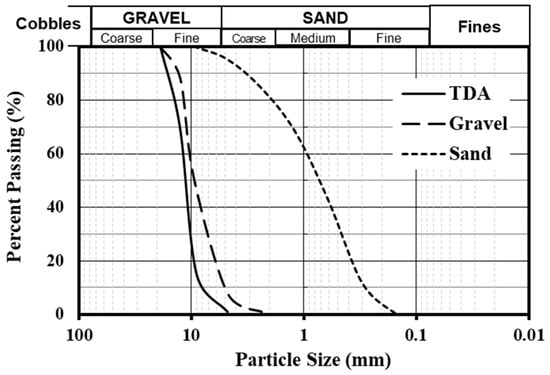
Figure 1.
Gradation curves of the materials used.

Table 2.
Material properties of the constituents used.

Table 3.
Physical properties of the used PVA fibers.
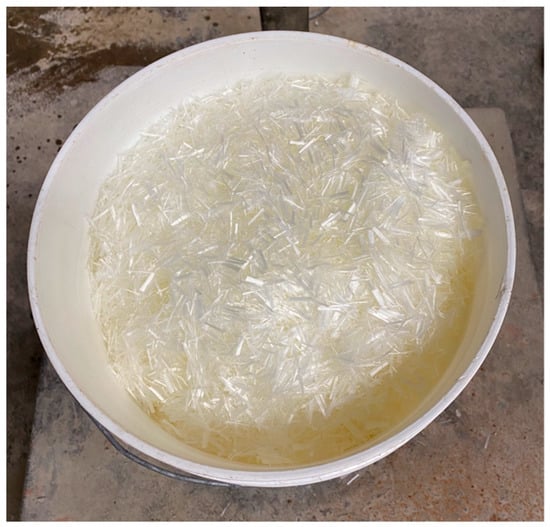
Figure 2.
Fiber type and shape.
2.2. Specimen Preparation
To ensure consistency, the same mixing procedure was used for all the mixtures. The total volume of concrete required for casting the specimens (including 10% leftover concrete) was determined. First, the interior of the mixing drum was wetted with water to minimize the absorption of water added as part of the mixture. The aggregates were then added to the drum of the rotary concrete mixer with one-quarter of the mixture water and left to mix for one minute. Next, the TDA was added and mixed with the aggregates for another minute. The cement was then added to the mixture and mixed for another minute. Finally, the remaining water and the superplasticizer were added to the mixture and allowed to mix for five minutes. The superplasticizer used was ‘Plastol 6400’, a polycarboxylate-based high-range water-reducing admixture. For mixtures with PVA fibers, the fibers were sprinkled onto the mixture by hand as the last step while the mixer continued to rotate at a normal speed to ensure good dispersion of the fibers. After introducing the fibers, mixing was continued for an additional 3 min. Upon completion of mixing, the concrete was dumped into a wheelbarrow and remixed with a shovel until it appeared uniform. The specimen slump tests were performed based on ASTM C143 [] to ensure the workability of the mixture and to determine the required amount of superplasticizer. If a slump test result was less than 100 mm, then more superplasticizer was added, and the concrete was mixed again until the 100 mm slump test requirement was reached. The target slump test result of 100 mm was achieved for all specimens by adding different amounts of superplasticizer. The fresh concrete was then poured into cylindrical plastic moulds with a diameter of 150 mm and height of 300 mm to produce the compressive strength and tensile strength specimens and into prism moulds measuring 100 mm × 100 mm × 355 mm to produce the flexural strength specimens, as illustrated in Figure 3. To ensure that there was no excess air in the fresh mixture, the concrete was poured in three layers, and each layer was evenly stroked 25 times with a tamping rod; then, the specimen was placed on a shaker and vibrated for 1 min. The specimens were subsequently held in the curing room for 28 days.
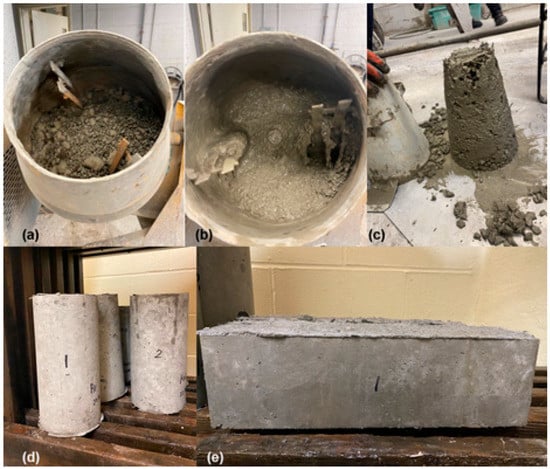
Figure 3.
Specimen preparation: (a) concrete material placed in the concrete mixer, (b) mixing of the concrete material, (c) conducting the slump test, (d) compressive and tensile strength specimens, and (e) flexural strength specimens.
2.3. Testing Program
2.3.1. Uniaxial Compression Test
As illustrated in Figure 4, in this study, uniaxial compression tests were conducted with a 2 MN universal electro-hydraulic servo testing machine using the displacement control approach. To obtain accurate test results, the capped concrete cylinders were centered on the compressive arms. The moving plates were then applied uniaxial compressive loading to the specimens at a rate of 0.5 mm/min, based on preliminary testing of the concrete cylinders. The displacement-controlled loading approach was selected to capture the post-peak behavior of the specimens. The compression tests followed the ASTM C39 [] testing procedure. The applied load was measured via a load cell, and the displacement was measured by using four linear potentiometers (LPs) connected to a data acquisition system. To detect lateral strains, LP #1 and LP #2 were positioned at opposite sides of the cylinder at mid-height (see Figure 4). The other two LPs were used to measure the vertical displacement and the accompanying vertical strains.
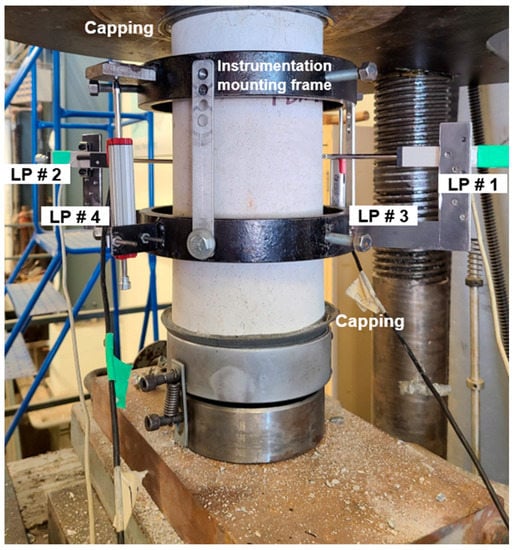
Figure 4.
Uniaxial compression test setup and instrumentation. LP: linear potentiometers.
2.3.2. Splitting Tensile Test
Splitting tensile tests were performed in accordance with the ASTM C496 [] testing method. As shown in Figure 5, the concrete cylinders were positioned horizontally between the plates of the testing machine. Loading was then applied until failure occurred due to indirect tension, resulting in vertical splitting along the diameter of the concrete cylinder. The applied load was measured with a load cell, and the displacement of the testing machine head was measured by using position transducers with a range of 0 to 100 mm. The tests were conducted at a controlled loading rate of 70 kN/min, equivalent to an indirect tensile stress of 0.98 ± 0.01 MPa per minute.
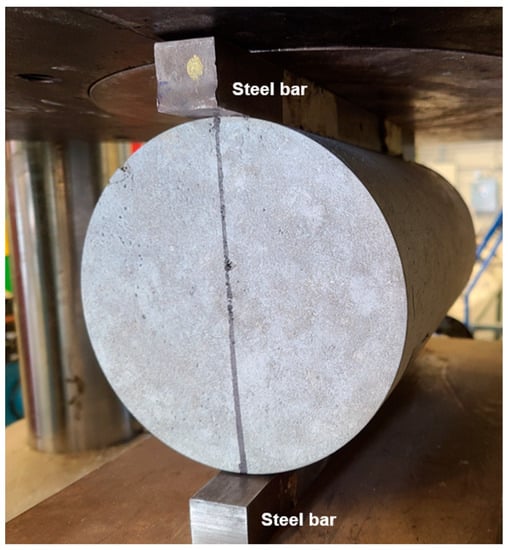
Figure 5.
Splitting tensile test setup.
2.3.3. Flexural Strength Test
Flexural strength tests were conducted in accordance with ASTM C78 [] in a servo-controlled material testing system (MTS) using displacement control. As shown in Figure 6, the specimens were positioned horizontally and rotated 90 degrees relative to their casting position. Four screws were used to attach a custom-made steel frame to the neutral axis of the concrete beam above the support points. The beams were loaded with a four-point flexural load until failure. The four-point loading was applied at a loading rate of 1 ± 0.1 MPa/min until fracture. The mid-span deflection of each flexural strength specimen was measured by two LVDTs positioned at the center of the specimen and on opposite sides of the frame. The load was measured via a load cell attached to the bottom of the crosshead. Details of the test setup are illustrated in Figure 6.
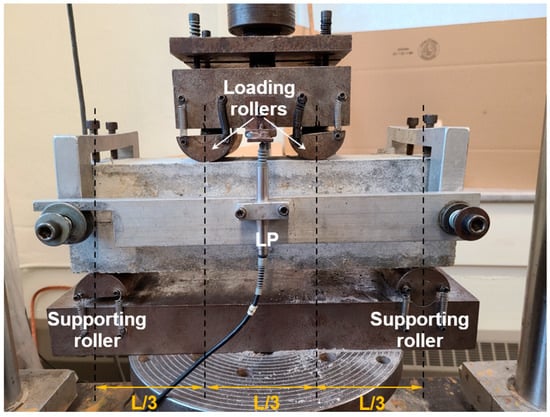
Figure 6.
Flexural strength test setup.
3. Results and Discussion
This section presents the results of the tests conducted. Two groups of mixtures were considered: mixtures with and without PVA fibers. In the first group, with no PVA fibers, seven different percentages of TDAs replacing coarse aggregates were tested: TDA 0% (the control specimen for the first group), TDA 10%, TDA 20%, TDA 40%, TDA 60%, TDA 80%, and TDA 100%. In the second group, with 1% PVA fibers, the same percentages of TDA were tested: TDA 0%-1% PVA (the control specimen for the second group), TDA 10%-1% PVA, TDA 20%-1% PVA, TDA 40%-1% PVA, TDA 60%-1% PVA, TDA 80%-1% PVA, and TDA 100%-1% PVA. In addition, to explore the workability, consolidation, design strength, and finishing of the design mixtures, initially, four trial mixtures without TDAs were prepared, which contained different percentages of PVA fibers: 0%, 1%, 1.5%, and 2% PVA. The workability and consistency of fresh concrete are critical determining factors for the quality of hardened concrete. Therefore, proper selection of the mixture ingredients, including the PVA fiber dosage, and adjustment of the mixture proportions to achieve the desired workability were critical. When PVA fibers are used in concrete, the workability of the concrete decreases due to water absorption by the fibers. Hossain et al. [] reported that PVA fibers significantly reduce the flowability and plastic viscosity of concrete. Shafiq et al. [] observed the need for an increased water-to-cement ratio and a sufficient superplasticizer dosage to meet the target slump test results for PVA fiber mixtures. In the present study, the desired workability was achieved for all mixtures by adding different amounts of superplasticizer, as described above. However, mixing difficulties and dispersion issues were experienced during the mixing of trial mixtures with PVA fiber dosages greater than 1% since the fibers tended to reaggregate and bind to each other, forming hairball-like clumps. Similar problems were reported by Dopko et al. []. Hence, it was decided that a PVA fiber dosage of 1% would be used for the second group of mixtures in this study.
3.1. Concrete Density
The unit weight was determined while the concrete was fresh by the method defined in ASTM C138 []. The unit weights for mixtures where coarse aggregates were replaced by TDAs ranged from 2344 kg/m3 for TDA 0% to 1667 kg/m3 for TDA 100%. Because weight is dependent on the mixture constituents, the rubberized concrete mixtures had a unit weight as much as 29% lower than that of normal concrete. Similar behavior was reported by Pham et al. [] and El Naggar et al. []. Details of the densities of the mixtures considered are presented in Figure 7.

Figure 7.
Relationship of concrete density to the percentage of TDA content.
3.2. Compressive Strength
As explained above, in accordance with ASTM C39, uniaxial compression tests were performed on 42 cylindrical test specimens measuring 150 mm × 300 mm at 28 days. In Figure 8, it can be seen that the TDA content had a significant effect on the compressive strength. For instance, TDA 10% specimens with no PVA exhibited a 25% drop in compressive strength compared to the TDA 0% control case, i.e., a decrease from 39.9 MPa to 29.8 MPa. However, in mixtures containing 1% PVA fibers, TDA 10%-1% PVA specimens exhibited a compressive strength loss of only 13% relative to the TDA 0%-1% PVA control case, i.e., a decrease from 42.8 MPa to 37.1 MPa. Similarly, TDA 20% specimens exhibited a 33% decrease in compressive strength compared to the TDA 0% control case, whereas TDA 20%-1% PVA specimens exhibited a compressive strength loss of only 22% relative to the TDA 0%-1% PVA control case. A comparison of the control cases TDA 0% and TDA 0%-1% PVA shows that the addition of 1% PVA fibers to specimens with no TDAs increased the compressive strength by only 7%, i.e., from 39.9 MPa to 42.8 MPa. However, the degree of improvement increased to 24% when 1% PVA was added to TDA 10% or TDA 20% specimens. Hence, it can be concluded that the addition of 1% PVA fibers improved the concrete compressive strength and reduced the rate of strength degradation as the TDA content increased. Likewise, it is evident from Figure 8 that as the TDA content increased, the rate of compressive strength loss became more gradual. This was observed for all test specimens with and without PVA fibers. As discussed in El Naggar et al. [], the reduction in compressive strength in concrete where coarse natural aggregates are replaced by the TDA is attributable to the lower modulus of elasticity of TDA in comparison to natural aggregates, as well as to the weaker bonding between TDA particles and the cement paste. Khatib and Bayomy [] gave a similar explanation for this behavior, where they believed that the occurring strength reduction with the increasing rubber content is attributed to a combination of two interacting mechanisms. First, on loading, as the TDA particles are much softer and more deformable than the surrounding cement paste, cracks initiate faster around the TDA particles in the mix, accelerating the failure of the rubber–cement matrix. In addition, due to the negligible adhesion between the TDA particles and the paste, soft rubber particles behave as voids in the concrete matrix, reducing the strength.
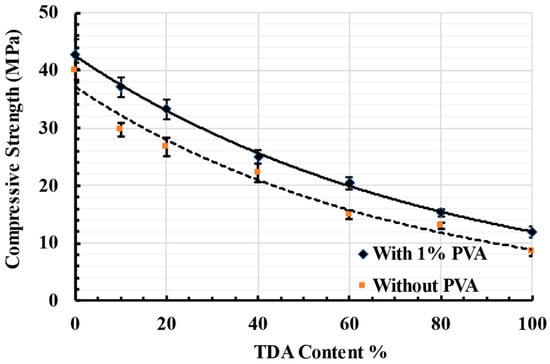
Figure 8.
Relationship of compressive strength to percentages of TDA content and PVA.
The compression test failure modes of specimens with different percentages of TDAs are illustrated in Figure 9 and Figure 10 for specimens with 0% and 1% PVA, respectively. From these figures, it can be seen that in contrast to the control specimens with no TDAs, the rubberized concrete did not exhibit brittle failure when loaded in compression. Larger macrocracks were qualitatively observed in the TDA 0% control specimens and in specimens with lower amounts of TDAs (i.e., TDA 20% or less), while microcracks were observed in the specimens containing greater amounts of TDAs. As shown in Figure 11, higher percentages of TDAs enabled the concrete specimens to undergo greater plastic deformation, which slowed the fracture process and allowed them to sustain larger strain values at the specimen peak compressive stress. This behavior is attributable to the ability of rubber particles to absorb a higher proportion of the imposed energy, thus withstanding greater deformations without full disintegration. In this case, the rubber particles act as springs, delaying the opening of cracks that develop and preventing complete disintegration of the concrete cylinder. Such energy absorption is an advantageous feature of rubberized concrete. Thus, rubberized concrete can be utilized for applications that do not need great compressive strength but instead require a more accommodating plastic behavior.
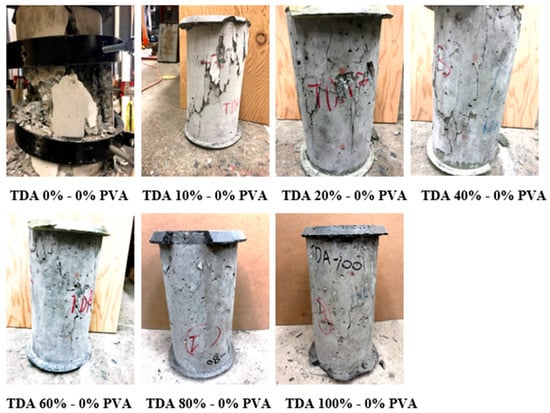
Figure 9.
Failure modes of test specimens without PVA fibers.
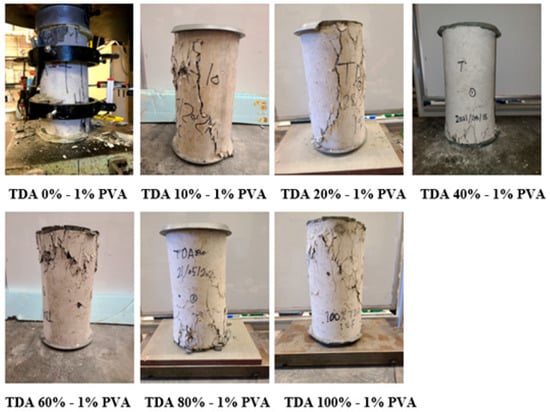
Figure 10.
Failure modes of test specimens with 1% PVA fibers.
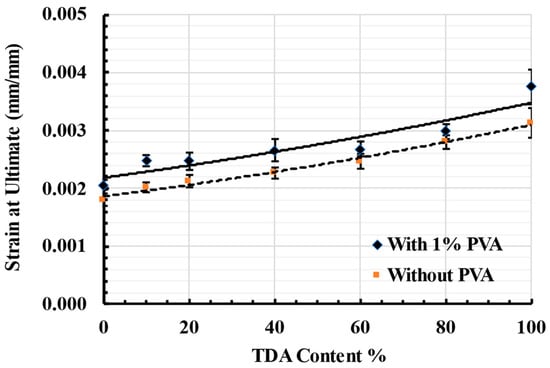
Figure 11.
Relationship of the strain at peak compressive stress to percentages of TDA content and PVA.
3.3. Modulus of Elasticity
The modulus of elasticity of test specimens at 28 days is plotted in Figure 12. The modulus of elasticity was obtained by calculating the slope of the relatively linear stress–strain curves up to 45% of the compressive strength. The results show that the modulus of elasticity of all the specimens decreased as the TDA content increased. In addition, a comparison of the trends in Figure 8 and Figure 12 indicates a direct relationship between the modulus of elasticity and the compressive strength, which is similar to trends observed in previous investigations of conventional concrete. Figure 12 shows that the TDA content has a significant effect on the modulus of elasticity. In comparison to the TDA 0% control case, TDA 10% specimens exhibited a 36% reduction in the modulus of electricity, a decrease from 33.5 GPa to 21.4 GPa. As the TDA content increased, a similar trend was observed in the specimens containing PVA fibers. However, the addition of PVA fibers resulted in a slightly improved modulus of elasticity.
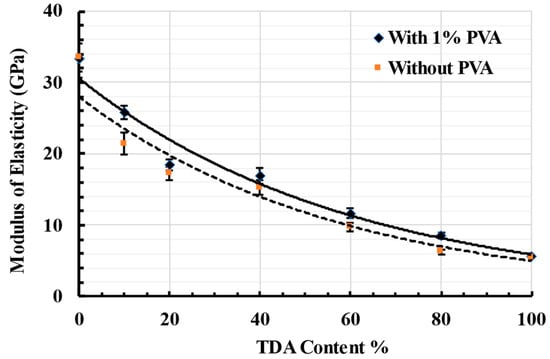
Figure 12.
Relationship of the modulus of elasticity to percentages of TDA content and PVA.
3.4. Splitting Tensile Strength
Figure 13 shows the relationship of the splitting tensile strength to the TDA content of the test specimens. It can be seen that for all percentages of TDAs, the splitting tensile strength of the concrete was improved by introducing PVA fibers to the mixture. However, the degree of improvement increased substantially for mixtures with higher percentages of TDAs. For instance, the addition of 1% PVA to TDA 80% specimens increased the tensile strength by an average of 35%, whereas the addition of 1% PVA to TDA 100% specimens increased the tensile strength by up to 66%. In general, the tensile strength decreased as the TDA content increased; however, all mixtures with PVA fibers exhibited greater tensile strength than the corresponding mixtures without PVA fibers. The decrease in strength with increasing TDA content is mainly attributable to the weak bonding between the TDA particles and the cement paste [,]. The mechanism of failure in the splitting tensile strength test is different from that in the compressive strength test, as the failure occurs along the paste and through the aggregates rather than the interfacial transition zone (ITZ) due to the bonds between the cement paste and the aggregate particles [].
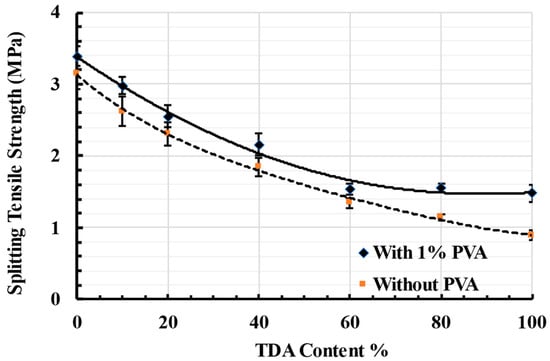
Figure 13.
Relationship of splitting tensile strength to percentages of TDA content and PVA.
3.5. Flexural Strength
The flexural strength tests showed that the control specimens with no TDAs withstood the greatest applied loads before fracture. As was the case in the compressive and tensile strength tests, the presence of TDAs in the mixtures likewise reduced the flexural strength of the concrete. Because TDA rubber particles form relatively weak interfacial bonds with the surrounding cement paste, failure occurred earlier in specimens with a higher rubber content. However, in the specimens with PVA, the reinforcing effect of the PVA fibers helped to compensate for the weak bonding of the TDA particles, thus partially overcoming the loss of strength. As shown in Figure 14, the flexural strength of concrete specimens with PVA fibers was approximately 30% greater than that of the corresponding specimens without PVA. A comparison of Figure 15 and Figure 16, presenting load versus deflection curves for specimens without PVA and with 1% PVA, respectively, shows that the introduction of PVA fibers not only restrained cracking but also provided significant residual post-peak strength. In Figure 14 and Figure 15, it can also be seen that specimens with a higher rubber content exhibited better deflection behavior.
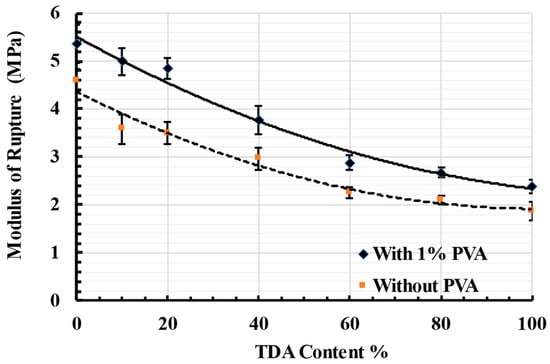
Figure 14.
Relationship of modulus of rupture to percentages of TDA content and PVA.
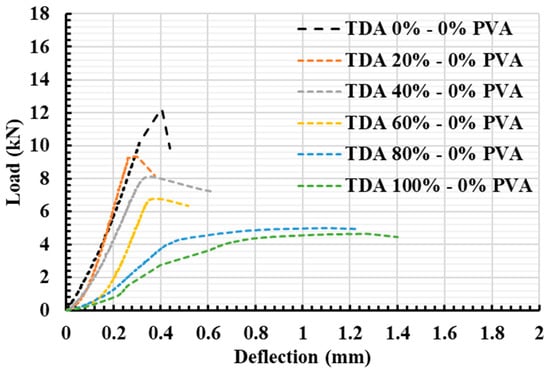
Figure 15.
Load versus deflection curves for specimens with different TDA contents and no PVA.
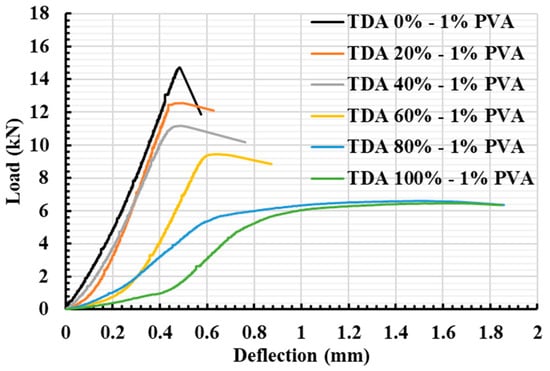
Figure 16.
Load versus deflection curves for specimens with different TDA contents, reinforced with 1% PVA.
4. Conclusions
This paper presents the results of a comprehensive experimental program to investigate the properties and behavior of rubberized concrete containing large particle (4.75 to 19 mm) tire-derived aggregates (TDAs), with and without enhancement by polyvinyl alcohol (PVA) fibers. Based on this study, the following observations can be made:
- −
- Trial mixtures with PVA fiber dosages exceeding 1% exhibited mixing difficulties, dispersion issues, and reduced flowability during mixing.
- −
- The rubberized concrete mixtures had a unit weight up to 29% lower than normal concrete because of the dependence of density on the mixture constituents.
- −
- When loaded in compression, the rubberized concrete did not exhibit brittle failure like that of the control specimens with no TDAs. Larger macrocracks were qualitatively observed in the TDA 0% control specimens and in specimens with low amounts of TDAs, while microcracks were observed in the specimens containing higher percentages of TDAs.
- −
- The TDA content had a significant effect on the compressive strength. For instance, specimens with 10% of the coarse aggregate by volume replaced by TDA exhibited a 25% decrease in compressive strength as compared to the control case with no TDAs, while specimens where 100% of coarse aggregates were replaced by TDAs exhibited a reduction in compressive strength of up to 77%.
- −
- However, a higher TDA content allowed specimens to undergo greater plastic deformation, thus slowing the fracture process and permitting specimens to sustain larger strain values at the peak compressive stress. This behavior is attributable to the ability of rubber particles to absorb a greater proportion of the imposed energy. Consequently, rubberized concrete can be utilized for applications that do not need high compressive strength but, instead, require a more accommodating plastic behavior, such as in slabs-on-grade and concrete pavement applications.
- −
- The addition of 1% PVA fibers to the mixtures enhanced the compressive strength of the specimens, reducing the loss of strength, in comparison to the TDA 0% control case, to 13% for TDA 10% and 69% for TDA 100%.
- −
- As expected, the TDA content had a major effect on the elastic modulus of rubberized concrete. However, the addition of PVA fibers was found to improve the modulus of elasticity slightly, providing a higher range of energy absorption.
- −
- For all TDA percentages, the tensile strength of the concrete was improved by introducing PVA fibers to the mixture, with a substantially greater degree of improvement at higher TDA percentages.
- −
- Because TDA rubber particles had relatively weak interfacial bonds with the surrounding cement paste, failure occurred earlier in specimens with a higher rubber content that resulted in lower flexure strength.
- −
- However, the addition of 1% PVA fibers to the specimens enhanced their flexural behavior. The reinforcing effect of the PVA fibers helped to compensate for the weak bonding of the TDA particles, thus partially overcoming the loss of strength.
Author Contributions
Conceptualization, H.E.N.; Data curation, H.E.N.; Funding acquisition: H.E.N. and A.M.A.A.; Investigation, H.E.N.; Supervision, H.E.N. and A.M.A.A.; Writing—original draft, H.E.N.; Writing—review and editing, H.E.N. and A.M.A.A. All authors have read and agreed to the published version of the manuscript.
Funding
This research received no external funding.
Data Availability Statement
The data presented in this study are available on request from the corresponding author.
Acknowledgments
The authors would like to express their gratitude to Liwa College of Technology, UAE, and Dalhousie University, Canada, for the provided support.
Conflicts of Interest
The authors declare no conflict of interest. The funders had no role in the design of the study; in the collection, analyses, or interpretation of data; in the writing of the manuscript, or in the decision to publish the results.
References
- United Nations. World urbanization prospects: The 2018 revision. Int. J. Psychol. 2018, S1, 443–447. [Google Scholar] [CrossRef]
- Wilson, D.C.; Velis, C.A. Waste management—Still a global challenge in the 21st century: An evidence-based call for action. Waste Manag. Res. 2015, 33, 1049–1051. [Google Scholar] [CrossRef]
- El Naggar, H.; Ashari, M.; Mahgoub, A. Development of an Empirical Hyperbolic Material Model for TDA Using Large Scale Triaxial Testing. Int. J. Geotech. Eng. 2021, 16, 133–142. [Google Scholar] [CrossRef]
- Canadian Association of Tire Recycling Agencies Annual Report 2020. 2020. Available online: https://www.catraonline.ca/storage/files/shares/publications-en/CATRA_AR_2020_ENG_FINAL.pdf (accessed on 1 November 2022).
- 2020 U.S. Scrap Tire Management Summary. 2020. Available online: https://www.ustires.org/sites/default/files/2019%20USTMA%20Scrap%20Tire%20Management%20Summary%20Report.pdf (accessed on 1 November 2022).
- Mahgoub, A.; El Naggar, H. Using TDA underneath shallow foundations: Simplified design procedure. Int. J. Geotech. Eng. 2022, 16, 787–801. [Google Scholar] [CrossRef]
- Mahgoub, A.; El Naggar, H. Using TDA as an Engineered Stress-Reduction Fill over Preexisting Buried Pipes. J. Pipeline Syst. Eng. Pract. 2019, 10, 04018034. [Google Scholar] [CrossRef]
- Mahgoub, A.; El Naggar, H. Coupled TDA–Geocell Stress-Bridging System for Buried Corrugated Metal Pipes. J. Geotech. Geoenviron. Eng. 2020, 146, 04020052. [Google Scholar] [CrossRef]
- Mahgoub, A.; El Naggar, H. Innovative Application of Tire-Derived Aggregate around Corrugated Steel Plate Culverts. J. Pipeline Syst. Eng. Pract. 2020, 11, 04020025. [Google Scholar] [CrossRef]
- Mahgoub, A.; El Naggar, H. Shallow foundations on lightweight TDA backfill: Field tests and 3D numerical modelling. Comput. Geotech. 2020, 126, 103761. [Google Scholar] [CrossRef]
- Mills, B.; El Naggar, H.; Valsangkar, A. Chapter 22 in Volume 2 of Ground Improvement Case Histories. In North American Overview and Canadian Perspective on the Use of tire Derived Aggregate in Highway Embankment Construction; Elsevier: Amsterdam, The Netherlands, 2015; pp. 635–655. [Google Scholar]
- Ahn, I.S.; Cheng, L. Tire derived aggregate for retaining wall backfill under earthquake loading. Constr. Build. Mater. 2014, 57, 105–116. [Google Scholar] [CrossRef]
- Moussa, A.; El Naggar, H. Numerical evaluation of buried wave barriers performance. Int. J. Geosynth. Ground Eng. 2020, 6, 56. [Google Scholar] [CrossRef]
- Ashari, M.; El Naggar, H.; Martins, Y. Evaluation of the Physical Properties of TDA-Sand Mixtures. In Proceedings of the 70th Canadian Geotechnical Conference (GeoOttawa 2017), Ottawa, ON, Canada, 1–4 October 2017. [Google Scholar]
- Zahran, K.; Naggar, H. Effect of Sample Size on T.D.A. Shear Strength Parameters in Direct Shear Tests. Transp. Res. Rec. 2020, 2674, 1110–1119. [Google Scholar] [CrossRef]
- El Naggar, H.; Zahran, K. Effect of the Particle Size on TDA Shear Strength Parameters in Triaxial Tests. Buildings 2021, 11, 76. [Google Scholar] [CrossRef]
- El Naggar, H.; Iranikhah, A. Evaluation of the Shear Strength Behavior of TDA Mixed with Fine and Coarse Aggregates for Backfilling around Buried Structures. Sustainability 2021, 13, 5087. [Google Scholar] [CrossRef]
- Indraratna, B.; Chu, J.; Rujikiatkamjorn, C. Ground Improvement Case Histories: Compaction, Grouting and Geosynthetics; Butterworth-Heinemann: Oxford, UK, 2015. [Google Scholar]
- Khatib, Z.K.; Bayomy, F.M. Rubberized Portland cement concrete. J. Mater. Civ. Eng. ASCE 1999, 11, 206–213. [Google Scholar] [CrossRef]
- Ghaly, A.M.; Cahill, J.D., IV. Correlation of Strength, Rubber Content, and Water to Cement Ratio in Rubberized Concrete. Can. J. Civ. Eng. 2004, 32, 1075–1081. [Google Scholar] [CrossRef]
- Pham, T.M.; Elchalakani, M.; Hao, H.; Lai, J.; Ameduri, S.; Tran, T.M. Durability characteristics of lightweight rubberized concrete. Constr. Build. Mater. 2019, 224, 584–599. [Google Scholar] [CrossRef]
- El Naggar, A.; El Naggar, H.; Sadeghian, P. Simplified Material Model for Concrete Containing High-Content of Tire-Derived Coarse Aggregate under Compression Loading. Can. J. Civil Eng. 2021, 48, 912–924. [Google Scholar] [CrossRef]
- Thomas, B.S.; Gupta, R.C. Long term behaviour of cement concrete containing discarded tire rubber. J. Clean. Prod. 2015, 102, 78–87. [Google Scholar] [CrossRef]
- Kaewunruen, S.; Li, D.; Chen, Y.; Xiang, Z. Enhancement of dynamic damping in eco-friendly railway concrete sleepers using waste-tyre crumb rubber. Materials 2018, 11, 1169. [Google Scholar] [CrossRef]
- Zhang, Z.; Ma, H.; Qian, S. Investigation on properties of ECC incorporating crumb rubber of different sizes. J. Adv. Concr. Technol. 2015, 13, 241–251. [Google Scholar] [CrossRef]
- Azevedo, F.; Pacheco-Torgal, F.; Jesus, C.; de Aguiar, J.L.B.; Camões, A.F. Properties and durability of HPC with tyre rubber wastes. Constr. Build. Mater. 2012, 34, 186–191. [Google Scholar] [CrossRef]
- Grinys, A.; Sivilevic, H.; Daukšys, M. Tyre rubber additive effect on concrete mixture strength. J. Civ. Eng. Manag. 2012, 18, 393–401. [Google Scholar] [CrossRef]
- Li, D.; Zhuge, Y.; Gravina, R.; Mills, J.E. Compressive stress strain behavior of crumb rubber concrete (CRC) and application in reinforced CRC slab. Constr. Build. Mater. 2018, 166, 745–759. [Google Scholar] [CrossRef]
- Moustafa, A.; ElGawady, M.A. Strain rate effect on properties of rubberized concrete confined with glass fiber-reinforced polymers. J. Compos. Constr. 2016, 20, 04016014. [Google Scholar] [CrossRef]
- Gonen, T. Freezing-thawing and impact resistance of concretes containing waste crumb rubbers. Constr. Build. Mater. 2018, 177, 436–442. [Google Scholar] [CrossRef]
- Si, R.; Wang, J.; Guo, S.; Dai, Q.; Han, S. Evaluation of laboratory performance of self-consolidating concrete with recycled tire rubber. J. Clean. Prod. 2018, 180, 823–831. [Google Scholar] [CrossRef]
- Rezvan, S.; Moradi, M.J.; Dabiri, H.; Daneshvar, K.; Karakouzian, M.; Farhangi, V. Application of Machine Learning to Predict the Mechanical Characteristics of Concrete Containing Recycled Plastic-Based Materials. Appl. Sci. 2023, 13, 2033. [Google Scholar] [CrossRef]
- Thomas, B.S.; Gupta, R.C. Properties of high strength concrete containing scrap tire rubber. J. Clean. Prod. 2016, 113, 86–92. [Google Scholar] [CrossRef]
- Eldin, N.N.; Senouci, A.B. Rubber-tire particles as concrete aggregate. J. Mater. Civ. Eng. ASCE 1993, 5, 478–496. [Google Scholar] [CrossRef]
- Siringi, G.M. Properties of Concrete with Tire Derived Aggregate and Crumb Rubber as a Ligthweight Substitute for Mineral Aggregates in the Concrete Mix. Ph.D. Thesis, University of Texas Arlington, Arlington, TX, USA, 2012. [Google Scholar]
- Nehdi, M.; Khan, A. Cementitious composites containing recycled tire rubber: An overview of engineering properties and potential applications. Am. Soc. Test. Mater. Cem. Concr. Aggreg. 2001, 23, 3–10. [Google Scholar]
- Zheng, L.; Huo, X.S.; Yuan, Y. Strength, modulus of elasticity, and brittleness index of rubberized concrete. J. Mater. Civil Eng. 2008, 20, 692–699. [Google Scholar] [CrossRef]
- Ling, T.C. Prediction of density and compressive strength for rubberized concrete blocks. Constr. Build. Mater. 2011, 25, 4303–4306. [Google Scholar] [CrossRef]
- Siddiqi, Z.; Hameed, R.; Akmal, U. Permeability and Strength Properties of Rubberized Concrete; Project Report; ASTM International: West Conshohocken, PA, USA, 2013; Available online: https://www.astm.org/studentmember/images/Study-of-the-Permeability-of-Rubberized-Concrete.pdf (accessed on 1 November 2022).
- Tehrani, F.M.; Miller, N.M. Tire-Derived Aggregate Cementitious Materials: A Review of Mechanical Properties. In Cement Based Materials; Saleh, H.E.M., Rahman, R.O.A., Eds.; IntechOpen: London, UK, 2018. [Google Scholar] [CrossRef]
- Arulrajah, A.; Mohammadinia, A.; Maghool, F.; Horpibulsuk, S. Tire derived aggregates as a supplementary material with recycled demolition concrete for pavement applications. J. Clean. Prod. 2019, 230, 129–136. [Google Scholar] [CrossRef]
- Li, V.C.; Wang, S.; Wu, C. Tensile strain-hardening behavior of polyvinyl alcohol engineered cementitious composite (PVA-ECC). ACI Mater. J.-Am. Concr. Inst. 2001, 98, 483–492. [Google Scholar]
- Alhozaimy, A.; Soroushian, P.; Mirza, F. Mechanical properties of polypropylene fiber reinforced concrete and the effects of pozzolanic materials. Cem. Concr. Compos. 1996, 18, 85–92. [Google Scholar] [CrossRef]
- Anas, M.; Khan, M.; Bilal, H.; Jadoon, S.; Khan, M.N. Fiber Reinforced Concrete: A Review. Eng. Proc. 2022, 22, 3. [Google Scholar] [CrossRef]
- Li, V.C.; Wu, C.; Wang, S.; Ogawa, A.; Saito, T. Interface tailoring for strain-hardening polyvinyl alcohol-engineered cementitious composite (PVA-ECC). Mater. J. 2002, 99, 463–472. [Google Scholar]
- Hossain, K.; Lachemi, M.; Sammour, M.; Sonebi, M. Influence of polyvinyl alcohol, steel, and hybrid fibers on fresh and rheological properties of self-consolidating concrete. J. Mater. Civ. Eng. 2012, 24, 1211–1220. [Google Scholar] [CrossRef]
- Shafiq, N.; Ayub, T.; Khan, S.U. Investigating the performance of PVA and basalt fibre reinforced beams subjected to flexural action. Compos. Struct. 2016, 153, 30–41. [Google Scholar] [CrossRef]
- C39/C39M; Standard Test Method for Compressive Strength of Cylindrical Concrete Specimens. ASTM International: West Conshohocken, PA, USA, 2005.
- C496; Standard Test Method for Splitting Tensile Strength of cylindrical Concrete Specimens. American Society for Testing and Materials: West Conshohocken, PA, USA, 1996; p. 496.
- C78; Standard Test Method for Flexural Strength of Concrete (Using Simple Beam with Third-Point Loading). American Society for Testing and Materials: West Conshohocken, PA, USA, 2010; Volume 100, p. 19428-2959.
- C136-06; Standard Test Method for Sieve Analysis of Fine and Coarse Aggregates. ASTM: West Conshohocken, PA, USA, 2006.
- C127; Standard Test Method for Relative Density (Specific Gravity) and 38 Absorption of Coarse Aggregate. ASTM: West Conshohocken, PA, USA, 2015.
- C128-12; Standard Test Method for Density, Relative Density (Specific Gravity), and Absorption of Fine Aggregate. ASTM International: West Conshohocken, PA, USA, 2012.
- C 29/C 29M; Standard Test Method for Bulk Density (“Unit Weight”) and Voids in Aggregate. ASTM: West Conshohocken, PA, USA, 2017.
- 143/C143M; Standard Test Method for Slump of Hydraulic-Cement Concrete. ASTM: West Conshohocken, PA, USA, 2010; Volume 4, pp. 89–91.
- Dopko, M.; Najimi, M.; Shafei, B.; Wang, X.; Taylor, P.; Phares, B.M. Flexural performance evaluation of fiber-reinforced concrete incorporating multiple macro-synthetic fibers. Transp. Res. Rec. J. Transp. Res. Board. 2018, 2672, 1–12. [Google Scholar] [CrossRef]
- C138; Standard Test Method for Unit Weight. Yield, and Air Content (Gravimetric) of Concrete. ASTM: West Conshohocken, PA, USA, 2001.
Disclaimer/Publisher’s Note: The statements, opinions and data contained in all publications are solely those of the individual author(s) and contributor(s) and not of MDPI and/or the editor(s). MDPI and/or the editor(s) disclaim responsibility for any injury to people or property resulting from any ideas, methods, instructions or products referred to in the content. |
© 2023 by the authors. Licensee MDPI, Basel, Switzerland. This article is an open access article distributed under the terms and conditions of the Creative Commons Attribution (CC BY) license (https://creativecommons.org/licenses/by/4.0/).